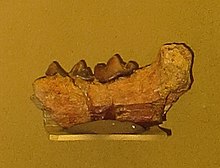| Mellivora benfieldi | |
|---|---|

| |
| Mellivora benfieldi mandible | |
|
Scientific classification
| |
| Domain: | Eukaryota |
| Kingdom: | Animalia |
| Phylum: | Chordata |
| Class: | Mammalia |
| Order: | Carnivora |
| Family: | Mustelidae |
| Genus: | Mellivora |
| Species: | †M. benfieldi
|
| Binomial name | |
| †Mellivora benfieldi Hendey, 1978
[1]
| |
Mellivora benfieldi or Benfield's honey badger is an extinct species of mustelid from the Late Miocene and Early Pliocene of Africa and possibly Europe.
Mellivora benfieldi is considered a likely ancestor of the living honey badger. [2] The genus Mellivora probably evolved from the more primitive Promellivora punjabiensis of India. The two genera are grouped together in the tribe Eomellivorini together with the extinct giant mustelids Eomellivora and Ekorus. [3]
Fossils of Mellivora benfieldi were first recovered from Langebaanweg in South Africa. Additional material probably from this species has also been found in the Middle Awash in Ethiopia. Fossils attributed to this species have also been found in southern Europe dated to the end of the Messinian; a migration of African mammals into mediterranean Europe has been noted at that time. [4]
Mellivora benfieldi was similar to the modern honey badger, but slightly smaller in size. Like its living relative, it had adaptations for digging and probably was an opportunistic predator. [3] [5]
- ^ Avery, D. Margaret (2019). A Fossil History of Southern African Land Mammals. Cambridge University Press. p. 60. ISBN 9781108480888.
- ^ Haile-Selassie, Yohannes (2009). Ardipithecus Kadabba: Late Miocene Evidence from the Middle Awash, Ethiopia. University of California Press. pp. 243–244. ISBN 9780520254404.
- ^ a b Valenciano, A.; Govender, R. (July 2020). "New fossils of Mellivora benfieldi (Mammalia, Carnivora, Mustelidae) from Langebaanweg, 'E' Quarry (South Africa, Early Pliocene) : re-evaluation of the African Neogene Mellivorines". Journal of Vertebrate Paleontology. 40 (4): e1817754. Bibcode: 2020JVPal..40E7754V. doi: 10.1080/02724634.2020.1817754. S2CID 227249176.
- ^ Neues Jahrbuch für Geologie und Paläontologie: Abhandlungen - Volume 252. E. Schweizerbart'sche Verlagsbuchhandlung. 2009. p. 49.
- ^ Taylor & Francis Group (November 2, 2020). "5-Million-Year-Old Honey Badger-Like Animal Discovered". SciTechDaily.
| Mellivora benfieldi | |
|---|---|

| |
| Mellivora benfieldi mandible | |
|
Scientific classification
| |
| Domain: | Eukaryota |
| Kingdom: | Animalia |
| Phylum: | Chordata |
| Class: | Mammalia |
| Order: | Carnivora |
| Family: | Mustelidae |
| Genus: | Mellivora |
| Species: | †M. benfieldi
|
| Binomial name | |
| †Mellivora benfieldi Hendey, 1978
[1]
| |
Mellivora benfieldi or Benfield's honey badger is an extinct species of mustelid from the Late Miocene and Early Pliocene of Africa and possibly Europe.
Mellivora benfieldi is considered a likely ancestor of the living honey badger. [2] The genus Mellivora probably evolved from the more primitive Promellivora punjabiensis of India. The two genera are grouped together in the tribe Eomellivorini together with the extinct giant mustelids Eomellivora and Ekorus. [3]
Fossils of Mellivora benfieldi were first recovered from Langebaanweg in South Africa. Additional material probably from this species has also been found in the Middle Awash in Ethiopia. Fossils attributed to this species have also been found in southern Europe dated to the end of the Messinian; a migration of African mammals into mediterranean Europe has been noted at that time. [4]
Mellivora benfieldi was similar to the modern honey badger, but slightly smaller in size. Like its living relative, it had adaptations for digging and probably was an opportunistic predator. [3] [5]
- ^ Avery, D. Margaret (2019). A Fossil History of Southern African Land Mammals. Cambridge University Press. p. 60. ISBN 9781108480888.
- ^ Haile-Selassie, Yohannes (2009). Ardipithecus Kadabba: Late Miocene Evidence from the Middle Awash, Ethiopia. University of California Press. pp. 243–244. ISBN 9780520254404.
- ^ a b Valenciano, A.; Govender, R. (July 2020). "New fossils of Mellivora benfieldi (Mammalia, Carnivora, Mustelidae) from Langebaanweg, 'E' Quarry (South Africa, Early Pliocene) : re-evaluation of the African Neogene Mellivorines". Journal of Vertebrate Paleontology. 40 (4): e1817754. Bibcode: 2020JVPal..40E7754V. doi: 10.1080/02724634.2020.1817754. S2CID 227249176.
- ^ Neues Jahrbuch für Geologie und Paläontologie: Abhandlungen - Volume 252. E. Schweizerbart'sche Verlagsbuchhandlung. 2009. p. 49.
- ^ Taylor & Francis Group (November 2, 2020). "5-Million-Year-Old Honey Badger-Like Animal Discovered". SciTechDaily.